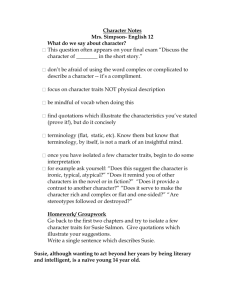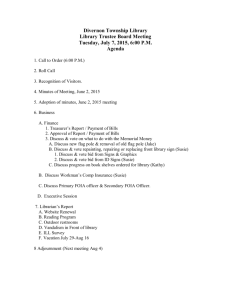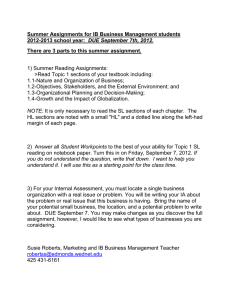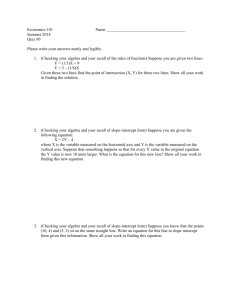analytical essay: the lovely bones
advertisement
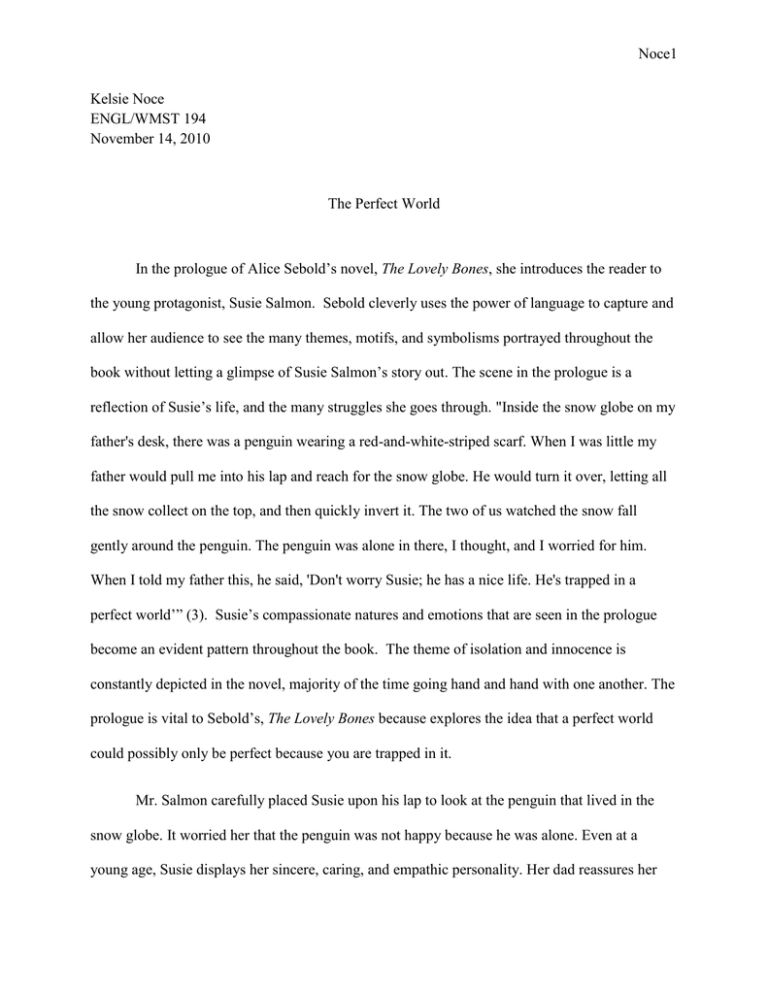
Noce1 Kelsie Noce ENGL/WMST 194 November 14, 2010 The Perfect World In the prologue of Alice Sebold’s novel, The Lovely Bones, she introduces the reader to the young protagonist, Susie Salmon. Sebold cleverly uses the power of language to capture and allow her audience to see the many themes, motifs, and symbolisms portrayed throughout the book without letting a glimpse of Susie Salmon’s story out. The scene in the prologue is a reflection of Susie’s life, and the many struggles she goes through. "Inside the snow globe on my father's desk, there was a penguin wearing a red-and-white-striped scarf. When I was little my father would pull me into his lap and reach for the snow globe. He would turn it over, letting all the snow collect on the top, and then quickly invert it. The two of us watched the snow fall gently around the penguin. The penguin was alone in there, I thought, and I worried for him. When I told my father this, he said, 'Don't worry Susie; he has a nice life. He's trapped in a perfect world’” (3). Susie’s compassionate natures and emotions that are seen in the prologue become an evident pattern throughout the book. The theme of isolation and innocence is constantly depicted in the novel, majority of the time going hand and hand with one another. The prologue is vital to Sebold’s, The Lovely Bones because explores the idea that a perfect world could possibly only be perfect because you are trapped in it. Mr. Salmon carefully placed Susie upon his lap to look at the penguin that lived in the snow globe. It worried her that the penguin was not happy because he was alone. Even at a young age, Susie displays her sincere, caring, and empathic personality. Her dad reassures her Noce2 that the penguin is in fact happy, that he couldn’t be anything but happy because he lives in a perfect world. A perfect world that the penguin is trapped in; the Salmons have no idea what the perfect world is but to make sure Susie knows that the penguin is safe, Mr. Salmon pretends to know that penguin inside the snow globe is happy. The idea of what true happiness is and if it exists is a question that reappears in the Salmons’ life over and over. The symbolism begins with the penguin sitting on top of Mr. Salmon’s desk. Penguins represent strong bonds and relationships. Penguins are very caring and loving to his or her mate or child; they are also very strong willed, instinctive and will do anything for its family. Sebold did not pick a random animal to be placed upon Mr. Salmon’s desk; in fact she chose the penguin because Jack Salmon is the family man who will never rest until justice is found for his daughter, Susie. He loves his daughter so much, when she turns up missing, he starts his own investigations. Mr. Salmon becomes paranoid and obsessed after an encounter with his odd neighbor, Mr. Harvey. Salmon’s impulse feelings and curiosity increase with every second of being in Harvey’s presence. “You know something,” Jack Salmon coldly said to Mr. Harvey (57). His fatherly instincts and persistence proves to be right, he wouldn’t rest until he could give evidence that Mr. Harvey was his daughter’s killer. The themes of innocence and isolation are apparent in Jack Salmon’s life, he wants to find his missing daughter which shows his innocence of how he wants his family to be whole and happy but along with innocence comes isolation. He isolates him self from his wife, children, and life by becoming obsessed with Mr. Harvey and only focusing on catching Harvey in his net of lies. The idea of the perfect world is one that Sebold plays with throughout the book. Using a snow globe in the prologue foreshadows how Susie sees earth. She can look down and watch but no matter what, she can never touch what is inside. Her worry for the penguin disappears when Noce3 her father explains to her how happy the animal is because he is in his own world, certainly Susie finds that being alone in your own world does not mean you are truly happy. She watches her family from Heaven, always questioning the line between earth and Heaven, Susie refers to this as the in between. As she is stuck in the in between, she imagines her perfect world but it seems so unattainable to Susie. As earth grew, Heaven stayed the same. Susie wanted to be alive still, experiencing what it was like to be in love, what it was like to grow up, and what it was like to be able to touch her family. “At fourteen, my sister sailed away from me into a place I’d never been. In the walls of my sex there was horror and blood, in the walls of hers there were windows”(125). In her heart, Susie knows she must let go of earth but seeing her sister pass her by and experience everything she never would makes her angry because she died with an unfulfilled life. Susie’s innocence was ultimately the death of her and the result was isolation from the rest of the world, just like the lone penguin in his snow globe. Susie desperately wanted to leave the past and the constant watching of her family, she wanted to be able to let go of her previous life, leaving the earth and her past behind her. Once after watching her brother on earth, Susie saw a man walking towards her. It was her grandfather who died years before. Seeing him made her feel small again and remembering how she visited him as a child. They danced for hours, just the two of them, both alone in heaven. Isolated in each others lonesome worlds, Susie remembered a song her grandfather used to cry to and she wanted to know why. “Sometimes you cry, Susie, even when someone you love has been gone a long time”(261). This helped Susie realize that even though you could be in a perfect world, there are still memories that are painful. Noce4 Snow globes are things people keep to remember certain times or people. It enables you to keep a small portion of something: a person, a pet, or a memory in the palm of your hand. Alice Sebold used the snow globe and the penguin as a foreshadowing of the entire lay out of the book and yet the story remains a mystery until you finish it. The way Sebold chose her wording shows the power of language and when put to use, it can allow you to enter another world. Innocence, isolation, loyality, and empathy are some on going feelings and patterns showed by the characters in The Lovely Bones. Without the feelings and persistant use of patterns, the audience would not be able to feel so attached to Susie and the Salmon family as one reads the book. By allowing these characteristics to shine through each character, Sebold captures, entizes and mesmorizes readers and has them gripping on the the edge of their seat, wanting more of The Lovely Bones.
